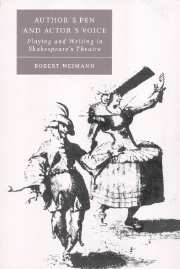Book contents
- Frontmatter
- Contents
- Preface
- Introduction: conjunctures and concepts
- 1 Performance and authority in Hamlet (1603)
- 2 A new agenda for authority
- 3 Pen and voice: versions of doubleness
- 4 Playing with a difference
- 5 Histories in Elizabethan performance
- 6 Hamlet and the purposes of playing
- 7 Space (in)dividable: locus and platea revisited
- 8 Shakespeare's endings: commodious thresholds
- Afterword: thresholds forever after
- Notes
- List of works cited
- Index
4 - Playing with a difference
Published online by Cambridge University Press: 22 September 2009
- Frontmatter
- Contents
- Preface
- Introduction: conjunctures and concepts
- 1 Performance and authority in Hamlet (1603)
- 2 A new agenda for authority
- 3 Pen and voice: versions of doubleness
- 4 Playing with a difference
- 5 Histories in Elizabethan performance
- 6 Hamlet and the purposes of playing
- 7 Space (in)dividable: locus and platea revisited
- 8 Shakespeare's endings: commodious thresholds
- Afterword: thresholds forever after
- Notes
- List of works cited
- Index
Summary
Elizabethan mise-en-scène, inflecting the interface of “author's pen” and “actor's voice,” could freely draw on an element of doubleness in the wide frame of its reference and function. Both written text and performance practice provided certain pre-established patterns for staging that, on a “scene individable,” involved not simply an assimilation of the disparity among these agencies of cultural production; in the process, this disparity could be turned to good account in a hybrid practice of staging that, for its reference and function, encompassed both standards of Renaissance rhetoric and poetics and a continuously viable tradition of common playing, jesting, and display.
In order to explore the theatrical uses of this doubleness further, I propose to introduce two Elizabethan terms, ‘contrariety’ and ‘disfigurement’ with which to specify the resulting purposes and effects of playing. The former, as suggested in the Introduction, is taken to connote not simply the existence on sixteenth-century stages of cultural disparity, but the ways and means by which this disparity could stimulate some “contrary” impulse to playing, a “contrarious” impetus in the production and reception of stage plays. While such ‘contrariety’ derives from a dramatically assimilated clash of two cultural patterns in staging and performing the play, ‘disfigurement’ more specifically points to certain sites of parody or resistance to Renaissance rhetoric, form, and proportion.
- Type
- Chapter
- Information
- Author's Pen and Actor's VoicePlaying and Writing in Shakespeare's Theatre, pp. 79 - 108Publisher: Cambridge University PressPrint publication year: 2000



